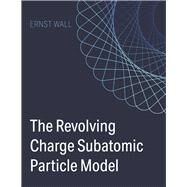The Revolving Charge Particle Model
, by Wall, Ernst- ISBN: 9781667867465 | 1667867466
- Cover: Paperback
- Copyright: 11/22/2022
The Revolving Charge Particle Model
We have developed a novel revolving charge model wherein the electron's tiny charge revolves at the speed of light in a Compton wavelength orbit. Using this, we can derive the magnetic moment (the Bohr magneton), identically, in three simple algebraic equations. (See Eqs. 1-1 through 1-3.)
We derive the mass-energy in 2 easy equations, and the spin-angular momentum, again, in 3 easy equations. Wave mechanics is not needed here, and the results speak for themselves.
We expand this to cover the proton, the neutron, and a Yukawa-like deuteron model made up of two revolving charge protons that are mutually attracted to a pion. Using the diameter of the protons and the quadrupole moment of the deuteron, we determine its dimensions. It is interesting to note that using these discrete charges and their spacing, the the graphically calculated electrostatic binding energy is 2.444 MeV whereas the known binding energy is 2.22 MeV. (We note that there are likely those that will be skeptical about these results, but they can easily do the math for themselves.)
We also study the effects of the Compton wavelets on the first Bohr radius. To do this, we have to define "electron coordinates" where the unit of time is the time that it takes for the revolving charge to do one revolution ( te = 8.09329979E-21 seconds ), the unit of length is the Compton wavelength, and the unit of mass is the mass of the electron. Velocity, of course, is Comptons per rotation.
The meson model provides the masses of the mesons below 4074 MeV . The Psi meson masses have accuracies of -1.3% to 4.7% . The meson series from the Eta through the A0(980) have errors ranging from 0.5% to – 2.3%. The remaining mesons have accuracies of -16% to +12%.
We have developed a novel revolving charge model wherein the electron's tiny charge revolves at the speed of light in a Compton wavelength orbit. Using this, we can derive the magnetic moment (the Bohr magneton), identically, in three simple algebraic equations. (See Eqs. 1-1 through 1-3.)
We derive the mass-energy in 2 easy equations, and the spin-angular momentum, again, in 3 easy equations. Wave mechanics is not needed here, and the results speak for themselves.
We expand this to cover the proton, the neutron, and a Yukawa-like deuteron model made up of two revolving charge protons that are mutually attracted to a pion. Using the diameter of the protons and the quadrupole moment of the deuteron, we determine its dimensions. It is interesting to note that using these discrete charges and their spacing, the the graphically calculated electrostatic binding energy is 2.444 MeV whereas the known binding energy is 2.22 MeV. (We note that there are likely those that will be skeptical about these results, but they can easily do the math for themselves.)
We also study the effects of the Compton wavelets on the first Bohr radius. To do this, we have to define "electron coordinates" where the unit of time is the time that it takes for the revolving charge to do one revolution ( te = 8.09329979E-21 seconds ), the unit of length is the Compton wavelength, and the unit of mass is the mass of the electron. Velocity, of course, is Comptons per rotation.
The meson model provides the masses of the mesons below 4074 MeV . The Psi meson masses have accuracies of -1.3% to 4.7% . The meson series from the Eta through the A0(980) have errors ranging from 0.5% to – 2.3%. The remaining mesons have accuracies of -16% to +12%.






